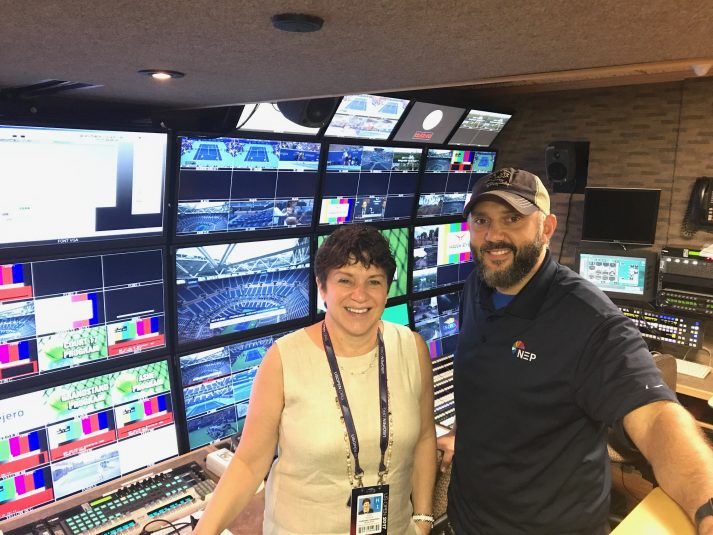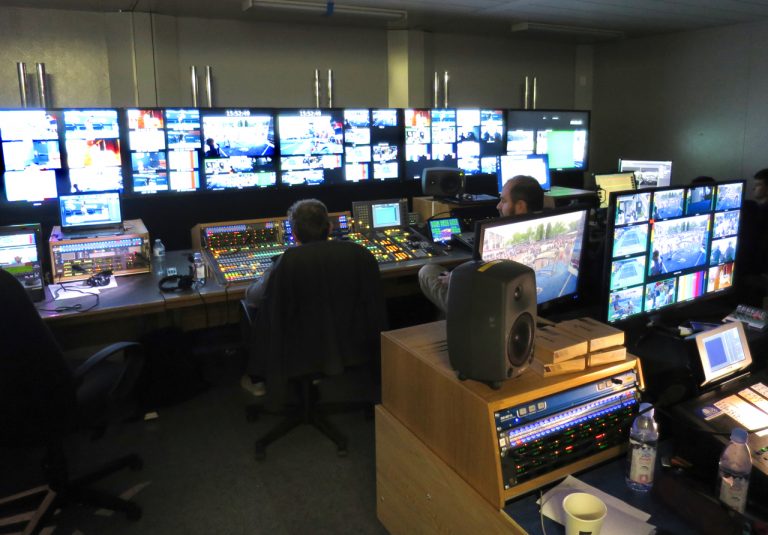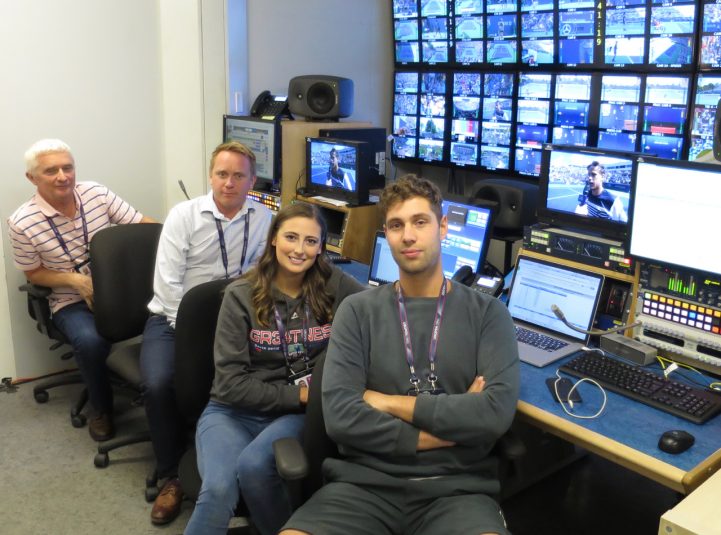Live From the US Open: USTA’s Patti Fallick Discusses the Transformation of Production Operations
This year lays groundwork for major developments coming at Billie Jean King National Tennis Center
Story Highlights
The physical transformation of the home of the US Open tennis championships, the USTA Billie Jean King National Tennis Center, has been undergoing a massive renovation for years, with upgrades to both courts and fan facilities. The broadcast side is also in the midst of a massive renovation as Patti Fallick, senior director of broadcast operations, USTA, and the team look to evolve a facility that can better meet the needs of rightsholders and, ultimately, fans around the globe.

USTA’s Patti Fallick (left) and NEP’s Nick Romano inside NEP Chromium, which is being used to produce the US Open world feed.
“All of the Grand Slams are different, and we want to be known as the innovative slam,” says Fallick. “We want to push the envelope on technology wherever we can, and doing that on the broadcast side is definitely very important.”
The finish line for new construction is in sight. Much of the major work will be completed by the time of the first serve of the 2018 US Open. But a few changes this year are setting a template for next year and making the facility an easier place for rightsholders to work onsite while also enhancing the offerings to rightsholders not onsite.
The biggest change this year was the decision to have ESPN, in addition to providing host-feed coverage, take on the additional responsibility for a distribution hub that makes signals available to rightsholders onsite and beyond.
“Unlike the other Slams, that are doing their own host feeds, we thought why do our own host feed when we have ESPN, which is the best in the business, to do this for us,” Fallick explains. “We wanted to expand their role so that, in addition to doing the host feed, they would handle the unilateral distribution hub and the whole thing from beginning to end.”
Gearhouse Broadcast was tapped to get the distribution hub up and running, and at the core of that hub is a 500×500 SAM router, Telex comms, and support gear. The hub is located inside another new feature this year: a series of interconnected flex cabins that replace the previously used straight office trailers. Gearhouse Broadcast also supplied the cabins.
“This gives our rightsholders the flexibility to create their own master control and other facilities to mirror what they would have if they were in a building,” says Fallick. “[Because] our rightsholders like to come onsite, we decided to step it up so they can showcase the US Open in the best possible light.”
Eurosport, for example, has a main production gallery as well as four control rooms for France, Germany, Spain, and the UK. Gearhouse Broadcast supplied the additional equipment for Eurosport’s expanded presence as well as for Japanese broadcaster Wowow.

Eurosport has a new production gallery that is larger than previous ones, thanks to a new flex-cabin infrastructure (and technical equipment and furniture) supplied by Gearhouse Broadcast.
“Previously, it was difficult, as the gallery needs specific furniture,” says Isabell Marsylle, production manager, Eurosport. “We have the gallery producing one show for the main international channel and then the different galleries for different versions. In those [smaller galleries], they can add in RF cameras or booth cameras and have access to the main router and all of the court feeds.”
Gearhouse Broadcast also helped fiber up the grounds and worked around the construction to make sure that fiber connectivity was in place where needed, including the temporary Armstrong Stadium structure. It’s all part of a growing Gearhouse presence that began two years ago when ESPN took over the domestic and host duties.
“This is the third year of our relationship with ESPN, and that facility is a tried and tested model,” says Ed Tischler, newly appointed managing director of Gearhouse Broadcast’s UK business. “New to that is sending feeds over the road to the unilateral distribution area.”
NEP, meanwhile, was signed on to provide technical facilities for the world feed, which is produced out of NEP Chromium. NEP NCP VIII was on hand for the DirecTV/ITV service during the first week.
“The truck is pulling double duty as Wazee is in the B unit and the quality of the truck is much better than what we had before,” notes Fallick. “It gives us the flexibility we need to provide signals to our partners and to produce the world feed, which is the best of US Open matches, tailored for our international audience.”
NEP Engineering Manager Nick Romano is onsite, heading an NEP team that also handles comms, the commentary booths, and camera setup for the in-venue productions.
The 2017 efforts are all part of a massive transition effort. Next year’s plans call for a new building that will house the international rightsholders and SMART production-control rooms, where automated cameras are cut by an operator; the big-screen in-venue video operations; and electronic line-calling on all courts.

From left: Gearhouse Broadcast’s Kevin Moorhouse, Edward Tischler, Lucie Slocombe, and Charles Morton in the new unilateral distribution hub at the US Open.
Another big change is that Level 3 circuits are onsite, used by IMG to deliver 16 discrete signals to Stockley Park outside London. Previously, only RCN and Verizon were available, so now there is a third option.
“It’s been working amazingly well, and everyone is extremely happy,” says Fallick. IMG’s production team in Stockley Park uses the new connectivity to create a daily highlights show, a preview show, and a review show.
Oliver Scott, head of technical services and business development, IMG Sports Media, sees the advances enhancing the offering to rightsholders who rely on IMG to get them content. Previously, those rightsholders had access only to a single world feed.
“This year, we have feeds from Arthur Ashe, Armstrong, and the Grandstand courts plus iso feeds of the other courts that are all fully produced. So all the courts are available and will be switched through with beauty shots to help rightsholders make more of their rights. We get a lot more content out so rightsholders can fill their platforms and digital offerings.”
Although the USTA has given ESPN more responsibility, the league has also taken a bit back: managing on-air talent that call matches.
“The announcers are now under the auspices of the USTA, but the flip side is, we had the fountain set from 11 a.m. to 6 p.m., which we never had before,” says Don Colantonio, executive producer, ITV productions, AT&T Entertainment Group. He and the ITV production team were onsite for Week 1 creating multiple-court coverage for DirecTV’s Mosaic service.
“With the fountain set, we could do wraps and generate content between matches and across all the DirecTV courts,” he says. “It’s like what we do at Wimbledon and the Australian Open, and the host set helps us tailor messaging.”
Although Fallick was hired prior to last year’s Open, this year’s event marks the first time she has overseen the entire year-long planning cycle. She has also had the chance to visit the other three Grand Slams and draw inspiration from their production teams.
“We all work well together, and we share best practice and learn from each other,” she says. “We’re all one big tennis family at the end of the day, and all the majors know what our broadcasters and partners want and give their best to make that happen.”
